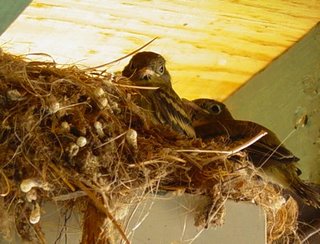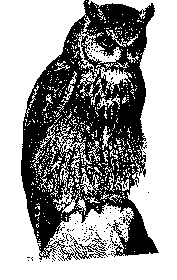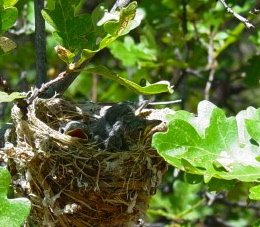Where Nature Meets Culture—Plus Wildfire, Dogs, Environmental News, and Writing with a Southern Rockies Perspective.
July 30, 2006
Redundancy helps America grow!
The Cañon Coffee Café is in full compliance with redundancy standards promulgated by the Office of Redundancy Office, a unit of the US Department of Commerce located on Table Mesa Drive in Boulder, Colorado.
Ants who aren't ants
And the only thing that even makes it marginally arguable is, as I have said, anthropomorphism gone pathological. As movie design, the ants have been prettified and given eloquent voice and movement; their pincers, meant to tear the flesh off other ants in their ceaseless wars, have been stylized into design accessories in the form of well-placed, clearly vestigial decorative shells resembling earrings. The ants aren't ants anymore, but human beings. Their very anthood, their genetic reality, has been obliterated and replaced with idealized archetypes from some touchy-feely new agey pacifist's infinitely superior brain.
I like a reviewer who can speak his mind. (Hat tip: Hell in a Handbasket.)
July 29, 2006
'Hunters, anglers should back roadless wild areas'
Colorado, too, is finishing this laborious and pointless roadless-area review--pointless because we went through it just a few years ago, and the public comments were overwhelmingly in favor of roadless areas then, as they were this year.
One quick excerpt from Hanson's piece:
Some say we need more roads for fire crews to fight wildfires. But according to the Forest Service, destructive fires occur much more frequently in roaded and logged areas than in roadless areas, and human-caused fires are almost five times more likely to start near a road. The Roadless Rule allows firefighters motorized access to fight wildfires within roadless areas.
Some hunters say roadless areas make hunting more difficult. But as true conservationist hunters, we should consider the health of the game first, our own convenience second. Several studies have shown that roadless areas make the best wildlife habitat. And I'm happy to work hard to enjoy a quality hunting experience in wild country unspoiled by the noise of vehicles.
Oh yeah, he's a Republican. Where do we get this idea that only Democrats favor environmental protection?
10-Bird Meme: No. 6, Cordilleran flycatcher
 Should you name a wild animal?
Should you name a wild animal? I have always tried to avoid it, on the principle that “Nature cares about species, not individuals.”
Still, if you are Doug Peacock or Timothy Treadwell, and the animals involved are individualistic and, more importantly, capable of eating you, it would be understandable if you would name them. Honorable adversaries and all that.
But what about small birds?
This summer a Cordilleran flycatcher (Empidonax occidentalis) nested on a porch beam. We had a nest there last year, and also once in the 1990s. M., who takes the position that wild animals are individuals, named her Lucinda, a name that sort of incorporated her “tseet” call and was also a bit of a tribute. Her mate became Sidney.
She laid four eggs. As happened last year, the fourth egg hatched late, and that chick soon disappeared from view. This morning, after not having checked the nest for a couple of days, I saw only two fledglings, almost fully feathered and sitting outside the nest, but still being fed a healthful diet of moths by their parents. Did the oldest already depart, or did #3 die? I plan to check the nest for remains but not until it is empty.
Last year and this, they have influenced our lives. We never turn on the porch light, and we shush the dogs when they bark directly underneath the nest. During the incubation, we peer out the living room window to see if the female is on her nest, and we worry when she is missing during a thunderstorm. We watched Sidney drive off a larger black-headed grosbeak who landed on the telephone wire too near the nest, while Lucinda beat up on a pine siskin likewise.
Of course, we really cannot do anything for the flycatchers other than having provided them with a convenient nesting ledge.
UPDATE, July 30: This morning when I checked the nest, the two fledglings were gone. Maybe #1 made an earlier departure after all. Unlike last year, there were no dessicated remains of #4 in the bottom of the next, so that hatchling's fate is a mystery.
Talk about feeling like “empty-nesters.”
Die, tamarisk, die!
From the Rocky Mountain News:
Releases in 2001 at four sites, two in Nevada and two in Utah, have matured and beetles are defoliating hundreds of acres of tamarisk. . . . beetles released in 2004 near Moab, Utah, are taking hold.
The tamarisk, a tree native to Eurasia, has crowded out native species such as willows and cottonwoods and sucked up vast amounts of water in the West.
Labor-intensive efforts to eradicate tamarisk cost $1,500 to $3,000 per acre. The tamarisk leaf beetles may be able to do the job for less than $10 per acre, according to U.S. Bureau of Land Management spokeswoman Mel Lloyd.
Are you cool enough to buy our stuff?
Is it the outdoor business in general: fly shops, bike shops, mountaineering shops?
You walk through the door, and the clerk's look says, "Are you cool enough to be shopping here? Do I recognize you from Outside or Fly Fisherman magazine?"
There are exceptions, of course. I nominate Absolute Bikes of Salida, Colorado, as a shop that is chock-full of bike geekiness, yet its staff seems attentive to every tourist who wanders in, not just to Lance Armstrong-wannabees.
So your choice is to try to get on the "known customer" list or to go to some big-box store where the selection is just the lowest common denominator, and the sales clerks (if you can find one) were working in consumer electronics or women's wear last week.
Baer says it:
At no time did anyone think to utter those 4 little words which are so noticeably lacking in the retail business these days: "May I help you?" Guy #2 was obviously too busy to bother with something so unimportant to the retail trade as helping a customer, or even being courteous. . . . I've worked retail. I know what it's like. Never, ever, during that time, did I fail to greet a customer, no matter how busy I was.
And you wonder why people are slow to take up these activities.
July 26, 2006
10-Bird Meme, No. 5: Broad-tailed hummingbird
It's wartime now on our front porch. Rufous hummingbirds, migrating south, have arrived in the breeding territory of "our" broad-tailed hummers. Try typing while a lilliputian version of The Dawn Patrol is being reenacted inches above your head.
Photo: Male broad-tailed hummingbird. Credit: Hummingbirds.net.
The annual struggle for control of vital airspace around the sugar-water feeder is event number four of the season.
First, in late April, season of snow and mud, comes one lone male broad-tailed hummingbird. You're outside thinking about all the storm-broken branches that need to be gathered, when you hear his rattling buzz (or "trilling whistle"). What do they eat before a single flower has bloomed and summer insects are not yet in the air? Tree sap?
Memory? The average lifespan in the wild is 1.6 years.
Then come the females, whom the males entice with thrilling U-shaped display flights. Then there are juvenals at the feeder in mid-summer, and then the war.
War ends with the departure of the rufous hummers, but the broad-tails linger, the population slowly dwindling until the last female disappears around the autumn equinox. And then summer truly is over.
When you take down the feeder to refill it, the hummers continue to fight over empty space. There is nothing there, but it's worth expending calories to defend it. Make your own parallel with human behavior.
July 24, 2006
Denver's dumbest criminal
I know that this link is off-topic for this blog, but it's a glimpse into the lifestyle of petty criminality.
July 22, 2006
Another Reason to Hate Disney
M. was reading it to her, and when she came to a page with the Australian children's song "Kookaburra sits in the old gum tree," she even pulled up the tune from the recesses of her memory.
Only in this book it was not a "gum tree" (eucalyptus, etc.) It was "oak tree." That's wrong on so many levels. Oaks are not native to Australia, but you can easily imagine that some Disney editor figured that "gum tree" would be confusing to American children. Perhaps they would imagine a tree whose leaves were sticks of chewing gum.
So they changed it, rather than taking an opportunity for education about another part of the world. Let's keep the world brightly colored, simple, and un-challenging. It's the Disney way.
July 19, 2006
Feral girl raised by dogs??
In this case, it's a woman raised by dogs. Judge for yourself.
July 17, 2006
La Leyenda Negra Meets Cocolitzli
Now a Mexican epidemiologist, studying chronicles and tree rings, thinks that the killer was actually a New World hemorrhaghic fever.
Cortés and his soldiers defeated, enslaved, and murdered the Aztecs, but now it seems that cocolitzli, a disease brought about by a native virus, is what really finished them off. Today the Aztec kingdom exists only in museums and ruins, but the virus could still be out there. As Mexico enters into yet another period of severe drought, could the killer reemerge?
Oh boy, a Mesoamerican Ebola virus. And we thought hantavirus was serious.
July 15, 2006
10-Bird Meme, No. 4: Mexican spotted owl
 |
| Mexican spotted owls (National Park Service) |
In 19th-century Irish slang, "the gentleman who paid the rent" was the tenant farmer's pig, a source of meat or cash.
In one 20th-century southern Colorado household--ours--the gentleman who paid the rent was Strix occidentalis lucida, the "Mexican" race of the spotted owl.
Our owling started on Earth Day, 1990. M. and I wandered past a little line of booths and tables set up in the Canon City Wal-Mart parking lot, stopping to talk with Cindy Rivera, then-district ranger for the Forest Service. She was recruiting volunteers, and one need was for people to conduct an owl census.
We said we would try it. Training was non-existent, but some local birders made us a tape of spotted owl calls. (After a year of carrying a tape recorder and speaker on the trail, we learned to make our own vocal calls.)
Then M. broke a toe while walking our irrigation ditch. Finally, in August, she was ready to go. Where should we go? At first, out of ignorance, we were searching up too high in the forest, but then I thought of a deep canyon that I had looked into while hunting.
We found a pair of owls there--and they was half of the spotted owls located in Colorado in 1990. Suddenly we were experts--or if not experts, at least respected.
he next spring, the local BLM office awarded us a small no-bid contract. After that, we did have to bid--against hungry grad students and professional wildlifers both. Forget your legendary $600 toilet seats--the taxpayers got their money's worth on owling contracts.
After four years of night-time hiking, calling, and filling out owl-census forms in triplicate, we were underbid in 1995 by about a penny an acre. For a little while, we felt terrible, deprived of our summertime vocation. But it was a rainy spring--which someone else got to endure--and my mother developed a fatal illness.
All in all, it was just as well that we did not have a census protocol to fulfill. Beside, the big owl-census push, fueled by a lawsuit against the federal Fish and Wildlife Service, was winding down.
And we were no longer financially strapped part-time academics. We had more income now, and we had moved into a house not many miles from our first successful owling location.
We called it, naturally, "Owl House." The gentleman had not merely paid the rent, he had helped with the mortgage too.
July 10, 2006
10-Bird Meme, No. 3: Raven

I was elk-hunting when I came to a place where someone else had cleaned a downed elk. White snow, red blood, black ravens.
Instantly, I was back in the visual world of the sagas that I read as a 15-year-old: Beowulf, The Destruction of Da Derga's Hostel, all that heroic slaughtering.
Letan him behindan hræ bryttian
sulwigpadan þone sweartan hræfn
They left behind them, to enjoy the corpses,
the dark coated one, the dark horny-beaked raven
Ravens carry so much mythological baggage that it is no wonder that they sometimes seem to walk with shoulders hunched.
Hugin (Thought) and Munin (Memory) perch on the shoulders of Odin. The illustration is from The Age of Fable by Thomas Bulfinch (Lothrop, Lee & Shepard Company, 1894).
"Can a raven miss anything? Can it keep a secret?" asks Bernd Heinrich rhetorically in Ravens in Winter. Sometimes scavengers, sometimes killers.
And if you have any acquaintance with Pacific Northwest culture, you know Raven's status there.
Contemporary European and American Paganism is full of people with "Raven" in their self-given names. One writer hits the trifecta. (Try it yourself.)
Icelandic bands use raven imagery, not surprising, considering the sagas.
When I was 12 or so, before I knew much about either sagas or Paganism, I designed my own heraldic raven insignia. Dad was amused, and whenever we were in the mountains and saw some of them, he would say, "Look, there are your birds."
OK. Ravens. They have been done and overdone. Now when I am driving down to Pueblo and I see a pair of them (usually eating road-killed jackrabbit), I wave and I say, "Hello, cousins." They need to eat, those sweartan hræfn.
July 09, 2006
Radar days
 "Radar days" are a summer phenomenon, when I spot clouds over the ridge to the west and load the Web page for Pueblo weather radar to see if any thunderstorms are developing and if they might rain here. (Please, pretty please.)
"Radar days" are a summer phenomenon, when I spot clouds over the ridge to the west and load the Web page for Pueblo weather radar to see if any thunderstorms are developing and if they might rain here. (Please, pretty please.)This week, it's been more like "Oh gawd, there's more." Or perhaps, "Here is the rain that you had on backorder."
My informal total for the week is 3.2 inches (8.1 cm), which is not much in some places but an awful lot for mountains to absorb, unless it comes as snow. Some areas have had more--roads are washed out and new ponds have appeared.
I took the photo of one of our rainwater tanks filling a week ago. They have been overflowing ever since. It is technically illegal under Colorado's complex water law to catch ("divert") rainwater, I am told, although I have never heard of anyone being prosecuted. After all, it will go onto the vegetable garden in its mini-drainage of orgin. No inter-gully transfers here.
The plumbeous vireo nest that I photographed on the 4th was empty on the 8th. Did the nestlings fledge that fast or did a predator get them? Quick research says that vireos need something like 12 days from hatching to fledging, but I do not know when these birds hatched. The female adult was still in the area.
Today, a 60-percent chance of heavy rain, and then some drier days.
July 08, 2006
July 07, 2006
It takes a book to raise a boy
A quote from an online review:
In celebrating old-fashioned boyhood and providing a blueprint on how to reclaim it, The Dangerous Book is revolutionary. It discards decades of social engineering that approaches children as being psychologically gender neutral. The book implicitly rebukes school texts that strip out gender references. Instead, it says 'boys will be boys'; they always have been, they always will be, and that's a good thing.
Thus The Dangerous Book achieves social revolution without preaching or politics; it does so in the name of fun.
The sort of fun promoted has also raised eyebrows. In a society that is preoccupied with safety, The Dangerous Book promotes activities in which boys are likely to get scuffed. This is a book for tree-climbers who occasionally pause to decipher enemy code or erupt into wood-wielding pirate fights.
There is a poignant quote from a father who (gasp!) actually let his kid use a pocket knife. That safety issue!
Via The Geek with a .45.
July 06, 2006
Mason Gulch Fire, one year later
"I'm going to walk up there and find out," she said. "I'll call you."
It turned out to be a "media event" to mark the first anniversary of last year's fire.
Mason Gulch was an intense fire because thick layers of gamble oak and fallen trees fueled the blaze, raising up 200-foot walls of flames, said [Mike] Smith [of the San Carlos Ranger District]. About 70 percent of the acres that burned in the Mason Gulch Fire were thoroughly destroyed, not leaving a single living tree behind. That is an usually high level of destruction for a wildfire, Smith said.
"We'll be taking pine cones from this area to plant our own seedlings," he explained. "That will take a couple of years before we can plant them."
....
Smith said Forest Service crews are also on the lookout for non-native weeds and plants, such as Canadian thistle and leafy spurge. Crews using pack mules in the hard terrain spray the weeds to keep them from spreading into the burned land.
Ah, a landscape of Gambel oak and cheatgrass. We really need to find a control for cheatgrass. I see it oozing in more and more. How did something like that evolve when its nutritional value for animals is so slow, except for a very short time in the spring?
UPDATE, JULY 7: Neither the Pueblo Chieftain nor the Canon City Daily Record employ reporters who can spell "Gambel." The Daily Record even referred to "gamble oak grass."
The Forest Service needs to provide better handouts for the news media: "This is a tree [photo]." "This is grass [photo]."
July 05, 2006
The man who took Michael Pollan hunting
Via What's in Rebecca's Pocket.
Kids who stay indoors
I am not a parent, but I keep my eyes open, and I do not think that the problem is the Web and television. After all, we have television, at least, when I was a kid.
More blame needs to be placed on the "safety" issue, I think.
"Parents are very busy, and outside play takes a lot of supervision," says Mary Rivkin, associate professor of education at the University of Maryland, Baltimore County. "We're also afraid about being outside because of strangers, the sun, and insects. Inside seems much safer."
July 04, 2006
10-Bird Meme: No. 2, Great Horned Owl

A misapprehension, a literary reference, an attack, an act of contrition.
1. One fall evening in 1990, M. and I were car-camping at some state-owned reservoir near Reno, Nevada. We put up our tent and went to bed. A loud commotion woke me from a deep sleep. It sounded like a pack of hyenas. But we were in Nevada, so they had to be Great Basin hyenas.
The sound was coming from a grove of cottonwood trees, I further realized, so they had to be Great Basin arboreal hyenas.
Finally, I awoke completely and realized I was listening to a single great horned owl.
2. Ornithologist Willian Dawson heard something similar when he was young:
At three o'clock one morning a horrible nightmare gave way to a more horrible waking. Murder most foul was being committed on the roof just outside the open window, and the shrieks of the victims (at least seven of them!) were drowned by the imprecations of the attacking party--fire-eating pirates to the number of a dozen.
For two weeks Dawson thought he had been an ear-witness to homicide, until he heard a second round of murder, looked out, and saw the owl on a church steeple, "gibbering and shrieking like one possessed" (William Leon Dawson, The Birds of California, 1923).
3. In the early 1990s, when we worked for the Bureau of Land Management doing Mexican spotted owl censuses, we had to fill out a report on every kind of owl we encountered. One great horned owl often showed up around 11 p.m. at a stock-watering trough near the Shelf Road rock-climbing area, north of Cañon City.
I had a camera rigged with two flash units, with which I tried to photograph owls, usually not too well. When I saw this owl on its usual fence post, I drove close in our VW Bug, keeping the headlights on the bird, grabbed my camera rig, and opened the door.
But the owl flew down toward the car. One the ground, it lifted its wings, clacked its beak in anger, and charged!
A couple of yards short of the front bumper, it came to its senses, stopped, and flew off into the night. I never got the picture.
4.When I was 13 or so, I was hunting rabbits with my father in a patch of trees on a farm near Fort Collins, Colorado, when he saw a horned owl sitting on a branch. He had been raised to kill "varmints," and owls were not yet federally protected raptors.
He told me to shoot it for the sake of the farmer's chickens. Not one to question the old man, I raised my 20-gauge and fired. It plunged down and for a sickening second I thought it was making a final swoop at me. But it hit the ground dead a short distance away.
Dad cut off one of the feet and showed me how the tendons made the talons open and close. That was interesting, yet I looked at the dead owl and thought, "I should never do this again." Not to an owl.
Feed me!

M. was sitting by her favorite contemplation tree when she noticed some activity in the oakbrush. A pair of plumbeous vireos were feeding their nestlings.
The plumbeous vireo used to be the gray ("plumbeous" = lead-colored") Rocky Mountain race of the solitary vireo before the last round of species-splitting. My old copy of Roger Tory Peterson's Field Guide to Western Birds contains nest descriptions, though, which Sibley's guide does not. "A neat basket hung from low branch of tree." Yep.
The song (132 kb WAV file), via Nature Songs.
July 02, 2006
Ten Birds: American Robin
 That's right, the robin, that unremarked bird of city lawns, parks, and golf courses. There is nothing special about robins, of course. You're out birding, you hear the sound of wings. You turn, look, and you say, "It's just a robin." (Photo: National Park Service)
That's right, the robin, that unremarked bird of city lawns, parks, and golf courses. There is nothing special about robins, of course. You're out birding, you hear the sound of wings. You turn, look, and you say, "It's just a robin." (Photo: National Park Service)If the male were a human, he would be some guy in a warm-up suit filling the gas tank of his minivan at a convenience store before going inside for an extra-large soda pop and some beef jerky. A Wal-Mart shopper.
The robin was a game bird during the "shoot everything" days of the 19th and early 20th centuries. Southerners baked "robin pie," while the old Audobon Society magazine, Bird-Lore, ran a photo of "a thrush, a warbler, a cowbird, two woodpeckers and seventeen robins with the caption, 'Contents of an [immigrant] Italian hunter's game bag'." (Joseph Kastner, A World of Watchers.)
On June 29 I was resting in a small meadow surrounded by firs, just below timberline in the Sangre de Cristo Range of southern Colorado. There in the trees were robins. They are everywhere, all the time, where the grasses meet the trees--and sometimes in the deep woods too.
They are survivors--cheerful and hardy, gobbling juniper berries near my house and pulling up worms that survive the chemical sprays on the manicured grass of suburban office parks.
We have built a landscape that they like, and no matter how loud the freeway traffic is, they cut loose at sunrise on summer days and sing madly about how much they are enjoying it.
The Ten (10) Bird Meme
I think it started as the ten most beautiful birds, but "beautiful" has evolved into "interesting."
My list will be starting soon, but do not expect all ten at once!
Yellowstone NP and the "Trophic Cascade"
I wanted to say something about the politics of the Rocky Mountain National Park elk cull--and I will--but meanwhile this fell into my lap, thanks to Mike Beagle of Backcountry Hunters and Anglers.
Here's the "nut graf," as we newsies like to say:
The apparent decline of biodiversity and biomass in Yellowstone’s northern range has confounded biologists for years. Yes, over-browsing remains a viable explanation. But was that the whole story? Couldn’t drought conditions and changes in climate, as well as gradual changes in the region’s hydrology explain why the cottonwoods, willows, and aspens weren’t regenerating, and why riparian zones were disappearing? Was it due, at least in part, to decades of fire suppression? What effects, if any, did the fires of 1988 have on the northern range? According to some prominent biologists, it wasn’t until 31 gray wolves were reintroduced in Yellowstone National Park in 1995-1996 that ecological diversity began to increase in the northern range, and, consequently, some of the answers to these questions were possible.
To read it, go here and scroll halfway down to the headline, "Yellowstone’s Trophic Cascade: Evidence of an Ecosystem on the Mend?
* Trophic cascade: "Three or more trophic levels linked by either predation or threat of predation that results in alternating increases or decreases in abundance or biomass."